Adobe's natural temperature regulation advantages come from its exceptional thermal mass properties. It absorbs heat during the day, keeping interiors cool, and releases it at night for warmth. This thermal lag moderates temperature fluctuations, making adobe ideal for climates with significant daily temperature swings. You'll benefit from reduced energy costs as adobe minimizes the need for artificial heating and cooling. Its high heat capacity and slow heat transfer create a comfortable, stable indoor environment year-round. Adobe's eco-friendly temperature control also contributes to improved air quality and overall well-being. Exploring adobe's full range of benefits reveals even more impressive advantages for sustainable living.
Thermal Mass Fundamentals
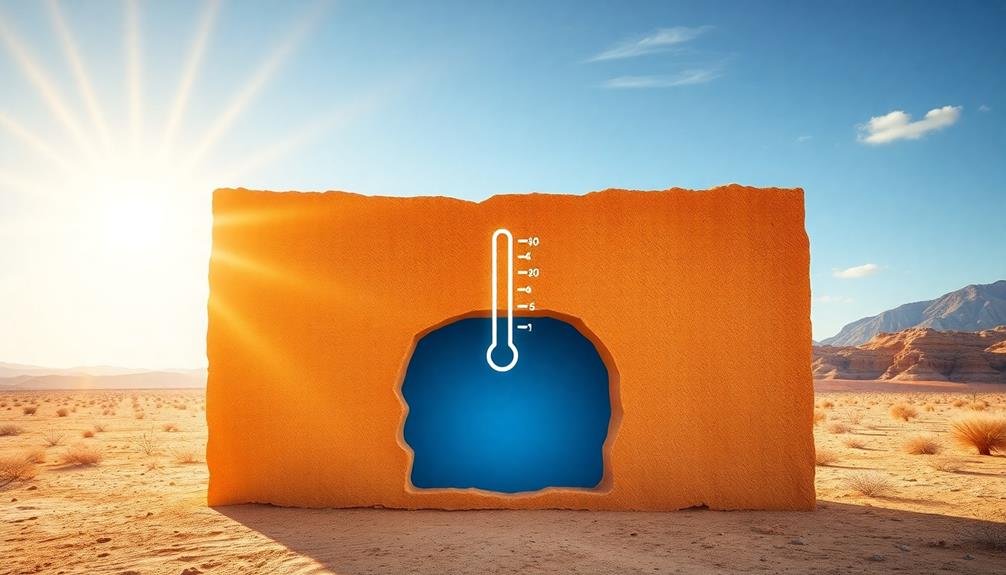
Understanding thermal mass is key to grasping adobe's natural temperature regulation advantages. Thermal mass refers to a material's ability to absorb, store, and release heat energy over time. Adobe, a dense earthen material, possesses excellent thermal mass properties due to its composition and thickness.
When you build with adobe, you're creating walls that act as heat sinks during the day and heat sources at night. As temperatures rise, adobe absorbs excess heat, keeping interiors cool. When temperatures drop, it releases stored heat, maintaining warmth inside.
This natural temperature regulation occurs through a process called thermal lag. Adobe's high thermal mass causes a delay in heat transfer, moderating temperature fluctuations throughout the day. The material's density and specific heat capacity determine its effectiveness.
You'll find that adobe's thermal mass benefits are most pronounced in climates with significant daily temperature swings. It's particularly effective in hot, arid regions where nighttime temperatures drop considerably.
Adobe's High Heat Capacity
Adobe's high heat capacity is a key factor in its impressive thermal mass properties.
You'll find that adobe walls absorb and store heat energy slowly, gradually releasing it over time.
This slow heat transfer process helps mitigate temperature fluctuations, keeping your indoor spaces cooler during hot days and warmer during cool nights.
Thermal Mass Properties
Why does adobe excel at regulating indoor temperatures? It's all about thermal mass properties. Adobe walls act as heat sinks, absorbing excess heat during the day and releasing it slowly at night. This natural process helps maintain a comfortable indoor climate without relying heavily on artificial heating or cooling systems.
The thermal mass of adobe works in three key ways:
| Property | Effect | Benefit |
|---|---|---|
| Heat absorption | Stores daytime heat | Reduces peak temperatures |
| Heat release | Radiates stored heat at night | Maintains warmth in cool hours |
| Time lag | Delays heat transfer | Stabilizes indoor temperature |
You'll find that adobe's high thermal mass considerably dampens temperature fluctuations. During hot days, it absorbs heat, keeping interiors cooler. As outside temperatures drop at night, the stored heat is gradually released, warming the space. This time lag in heat transfer is vital for maintaining a stable indoor environment.
Adobe's thermal mass properties also work in colder climates. The material absorbs heat from the sun or internal sources during the day, then slowly releases it at night, reducing the need for additional heating. This natural temperature regulation makes adobe an energy-efficient and environmentally friendly building material.
Slow Heat Transfer
Heat capacity, a key factor in adobe's temperature regulation prowess, sets this material apart from conventional building options. Adobe's high heat capacity means it can absorb and store a significant amount of thermal energy without drastically changing its own temperature. This property contributes to its slow heat transfer, creating a buffer against rapid temperature fluctuations.
When you're inside an adobe structure, you'll notice that it takes longer for the heat of the day to penetrate the walls. As the sun beats down, the adobe slowly absorbs the heat, keeping the interior cooler for extended periods.
Conversely, as temperatures drop at night, the stored heat is gradually released, maintaining a warmer indoor environment. This slow heat transfer characteristic of adobe helps stabilize internal temperatures, reducing the need for artificial heating and cooling.
You'll find that adobe buildings can maintain comfortable conditions for hours after external temperatures have changed dramatically. This natural temperature regulation not only enhances comfort but also contributes to energy efficiency, as you'll rely less on HVAC systems to maintain a consistent indoor climate.
Temperature Fluctuation Mitigation
A key advantage of adobe's high heat capacity is its ability to mitigate temperature fluctuations. This property allows adobe structures to maintain a more stable internal temperature throughout the day and night. You'll experience fewer drastic temperature swings inside an adobe building compared to structures made of other materials.
Adobe's thermal mass absorbs heat during the day and releases it slowly at night, creating a natural temperature regulation system. This effect is particularly beneficial in climates with significant temperature variations between day and night. Here's a comparison of temperature fluctuations in different building materials:
| Time | Adobe | Wood Frame | Concrete |
|---|---|---|---|
| 6 AM | 68°F | 62°F | 65°F |
| 12 PM | 72°F | 78°F | 75°F |
| 6 PM | 75°F | 82°F | 79°F |
| 12 AM | 71°F | 70°F | 72°F |
| 6 AM | 69°F | 64°F | 67°F |
As you can see, adobe maintains a more consistent temperature range, reducing the need for artificial heating and cooling. This natural temperature regulation not only enhances comfort but also contributes to energy efficiency in adobe buildings.
Solar Heat Gain Reduction

Adobe's solar heat gain reduction capabilities stem from its impressive thermal mass properties.
You'll find that adobe walls absorb and store heat during the day, slowly releasing it at night, which helps maintain a stable indoor temperature.
Additionally, the high-albedo surface of adobe structures reflects a significant amount of sunlight, further reducing heat absorption and keeping interiors cooler.
Thermal Mass Properties
The thermal mass properties of adobe structures contribute markedly to their ability to reduce solar heat gain. Adobe's high thermal mass allows it to absorb and store heat during the day, slowly releasing it at night when temperatures drop. This process helps maintain a more stable indoor temperature, reducing the need for artificial cooling and heating.
You'll find that adobe walls, typically 10 to 14 inches thick, act as natural thermal batteries. They absorb heat slowly during peak sunlight hours, preventing rapid temperature increases inside the building.
As the day progresses, the stored heat gradually moves through the wall, reaching the interior space in the cooler evening hours. This time-delayed heat transfer, known as the "thermal lag" effect, can shift peak indoor temperatures by 6 to 8 hours compared to outdoor conditions.
As a result, you'll experience a cooler interior during hot afternoons and warmer spaces at night. The thermal mass properties of adobe also help dampen temperature fluctuations, creating a more comfortable living environment with less reliance on energy-intensive HVAC systems.
High-Albedo Surface Reflection
High-albedo surface reflection is another key factor in adobe's natural temperature regulation. When you're looking at adobe structures, you'll notice their light-colored, often whitewashed exteriors. This isn't just for aesthetics; it's an essential feature that helps keep the building cool.
The high albedo of adobe surfaces means they reflect a significant amount of solar radiation. Instead of absorbing heat from the sun, these surfaces bounce it back into the atmosphere. This reflection can reduce the amount of heat that enters the building by up to 30%.
You'll find this particularly effective in hot, sunny climates where solar heat gain is a major concern. By reflecting sunlight, adobe buildings minimize the need for artificial cooling, saving energy and maintaining a comfortable interior temperature.
The reflective properties of adobe surfaces also contribute to the urban heat island effect mitigation. In areas with multiple adobe structures, the collective reflection can help lower the overall temperature of the surrounding environment, creating a more pleasant microclimate for the community.
Nighttime Cooling Effect
How does adobe continue to benefit homeowners even after the sun sets? Adobe's nighttime cooling effect is a significant advantage in temperature regulation. During the day, adobe walls absorb heat, but as temperatures drop in the evening, they slowly release this stored warmth. This process helps maintain a comfortable indoor temperature throughout the night.
You'll experience several benefits from adobe's nighttime cooling effect:
| Benefit | Impact |
|---|---|
| Energy savings | Reduced need for artificial heating |
| Comfort | Stable indoor temperature overnight |
| Environmental impact | Lower carbon footprint |
| Cost-effectiveness | Decreased utility bills |
The thermal mass of adobe walls acts as a natural temperature buffer, smoothing out temperature fluctuations between day and night. This effect is particularly valuable in desert climates with significant diurnal temperature swings. You'll find that adobe homes require less energy for heating and cooling, as the structure naturally moderates temperature extremes.
Delayed Temperature Fluctuations
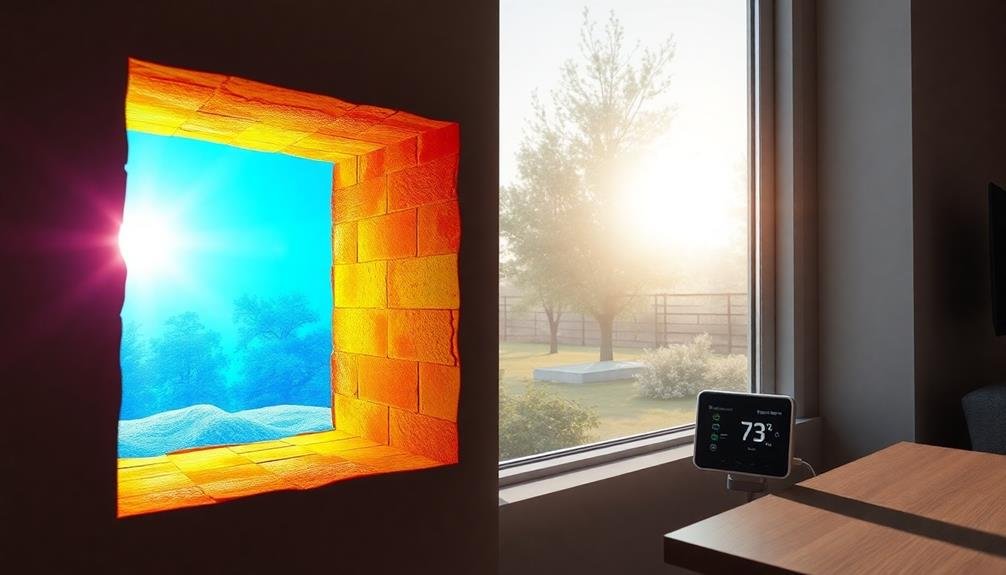
Adobe's thick walls act as a thermal mass, absorbing heat during the day and releasing it slowly at night.
You'll notice that this property helps to reduce temperature swings inside your adobe home.
As outdoor temperatures fluctuate, your adobe structure's heat absorption and release cycle creates a more stable indoor climate.
Heat Absorption and Release
One of the most impressive features of adobe construction is its ability to absorb and release heat gradually. This characteristic stems from adobe's high thermal mass, which allows it to store and distribute heat over time.
During hot days, you'll find that adobe walls absorb excess heat from the environment, keeping the interior cooler. As night falls and temperatures drop, the stored heat is slowly released back into the living space.
This process creates a natural temperature regulation system that can considerably reduce your reliance on artificial heating and cooling. You'll notice that adobe structures maintain a more consistent internal temperature throughout the day and night.
The heat absorption and release cycle helps to mitigate extreme temperature swings, providing a more comfortable living environment.
Additionally, adobe's porous nature contributes to its heat management properties. The tiny air pockets within the material act as insulators, further enhancing its ability to regulate temperature.
As a result, you'll experience fewer drafts and cold spots in an adobe home, leading to improved overall comfort and energy efficiency.
Thermal Mass Properties
The thermal mass properties of adobe contribute greatly to its temperature regulation capabilities. Adobe's high thermal mass allows it to absorb and store heat during the day, slowly releasing it at night. This process creates a natural delay in temperature fluctuations, keeping your home cooler during hot days and warmer during cool nights.
You'll notice that adobe walls take longer to heat up and cool down compared to other building materials. This slow response to temperature changes helps maintain a more stable indoor environment.
The thickness of adobe walls also plays a significant role in this process, as thicker walls have greater thermal mass and provide better insulation.
The benefits of adobe's thermal mass properties include:
- Reduced energy costs for heating and cooling
- More comfortable indoor temperatures year-round
- Decreased reliance on artificial climate control systems
- Protection against sudden temperature swings
Temperature Swing Reduction
Along with its thermal mass properties, adobe excels at reducing temperature swings inside your home. This advantage is particularly noticeable in regions with significant day-to-night temperature fluctuations.
Adobe walls absorb heat during the day and slowly release it at night, creating a more stable indoor environment.
You'll experience fewer drastic temperature changes throughout the day, as the adobe structure acts as a buffer against external temperature extremes. This delayed heat transfer process, known as "thermal lag," can shift peak indoor temperatures by several hours.
As a result, your home remains cooler during hot afternoons and warmer during chilly nights.
The temperature swing reduction effect is enhanced by adobe's thickness and density. Thicker walls provide greater insulation and thermal storage capacity, further smoothing out temperature variations.
This natural temperature regulation can lead to increased comfort and reduced reliance on artificial heating and cooling systems.
Passive Heating in Winter
During winter months, adobe structures excel at passive heating, leveraging their unique thermal properties to maintain comfortable indoor temperatures.
You'll find that adobe walls absorb and store heat from the sun during the day, slowly releasing it into the interior spaces at night. This process, known as thermal mass, helps regulate indoor temperatures naturally.
To maximize passive solar heating in adobe homes, you'll want to evaluate proper orientation and window placement. South-facing windows allow more sunlight to enter during winter, warming the adobe walls and floors.
These surfaces then radiate heat back into the room, creating a cozy environment without relying heavily on artificial heating systems.
Adobe's passive heating benefits include:
- Reduced energy consumption for heating
- More consistent indoor temperatures
- Lower utility bills during winter months
- Improved thermal comfort for occupants
You'll also notice that adobe's high thermal mass helps prevent rapid temperature fluctuations, keeping your home warmer for longer periods.
This natural insulation property means you won't need to run your heating system as frequently, saving both energy and money.
Natural Cooling in Summer

Summer's scorching heat is no match for adobe's natural cooling capabilities. You'll find that adobe structures remain comfortably cool even during the hottest months. The thick walls absorb heat during the day, preventing it from reaching the interior. At night, this stored heat radiates outward, maintaining a stable indoor temperature.
Adobe's thermal mass is key to its cooling properties. The dense material slows heat transfer, creating a time lag between outdoor and indoor temperature changes. This phenomenon, known as "thermal lag," can keep your adobe home cool for hours after the sun has set.
Here's a breakdown of adobe's cooling features:
| Feature | Function | Benefit |
|---|---|---|
| Thick Walls | Heat absorption | Delayed heat penetration |
| Thermal Mass | Slow heat transfer | Stable indoor temperature |
| Night Cooling | Heat radiation | Natural temperature regulation |
You can enhance adobe's natural cooling by incorporating design elements like strategically placed windows for cross-ventilation and overhanging roofs for shade. These features work in tandem with adobe's inherent properties to create a comfortable living environment, reducing or eliminating the need for artificial cooling systems and saving you energy costs in the long run.
Energy Efficiency Benefits
Adobe's natural cooling properties lead to significant energy efficiency benefits.
You'll find that adobe structures require less energy for cooling, resulting in lower electricity bills and reduced environmental impact. The thick walls and thermal mass of adobe absorb heat during the day and release it slowly at night, maintaining a more consistent indoor temperature.
This natural temperature regulation means you'll rely less on air conditioning systems, reducing your energy consumption and carbon footprint.
Adobe's energy efficiency extends beyond just cooling, as it also helps with heating in colder months. The material's ability to store and release heat gradually works both ways, keeping your home warmer in winter without excessive heating costs.
Consider these energy efficiency benefits of adobe construction:
- Lower electricity bills due to reduced HVAC usage
- Decreased reliance on fossil fuels for cooling and heating
- Smaller carbon footprint and environmental impact
- Potential for achieving net-zero energy status more easily
Humidity Regulation Properties
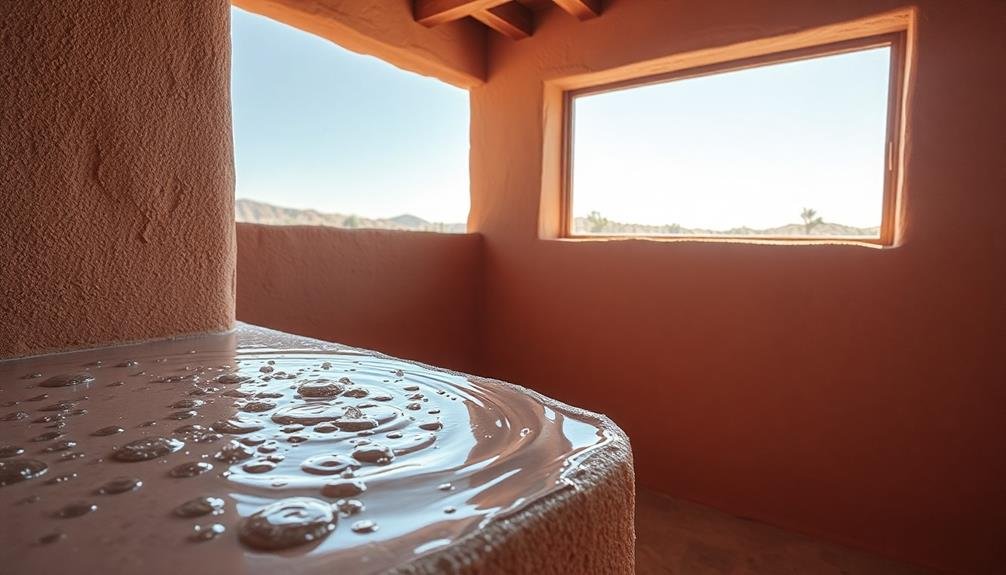
While adobe's temperature regulation is impressive, its ability to manage humidity is equally remarkable. Adobe walls naturally absorb excess moisture from the air when humidity levels are high and release it back when the air becomes drier. This process, known as hygroscopic buffering, helps maintain a comfortable and consistent indoor environment.
You'll find that adobe's porous structure allows it to absorb up to 30% of its weight in water vapor without compromising its structural integrity. This means your home can effectively regulate humidity levels without the need for energy-intensive dehumidifiers or humidifiers. As a result, you'll experience fewer issues related to high humidity, such as mold growth or musty odors.
Adobe's humidity regulation properties also contribute to improved indoor air quality. By reducing excessive moisture, it helps prevent the growth of allergens and other harmful microorganisms.
You'll likely notice that your adobe home feels more comfortable year-round, with fewer fluctuations in humidity levels. This natural ability to balance moisture content can lead to better respiratory health and overall well-being for you and your family.
Reduced HVAC Dependency
The natural temperature and humidity regulation properties of adobe structures lead to a significant reduction in HVAC dependency.
You'll find that adobe homes require less artificial heating and cooling, resulting in lower energy consumption and reduced utility bills. This decreased reliance on mechanical systems not only saves you money but also minimizes your environmental impact.
Adobe's thermal mass absorbs heat during the day and releases it at night, creating a natural heating and cooling cycle. This means you won't need to run your air conditioning or heating as frequently or intensely as in conventional buildings.
Additionally, adobe's ability to regulate humidity helps maintain a comfortable indoor environment without the need for energy-intensive dehumidifiers or humidifiers.
The reduced HVAC dependency in adobe structures offers several benefits:
- Lower energy costs
- Decreased carbon footprint
- Extended HVAC system lifespan
- Improved indoor air quality
Long-Term Cost Savings
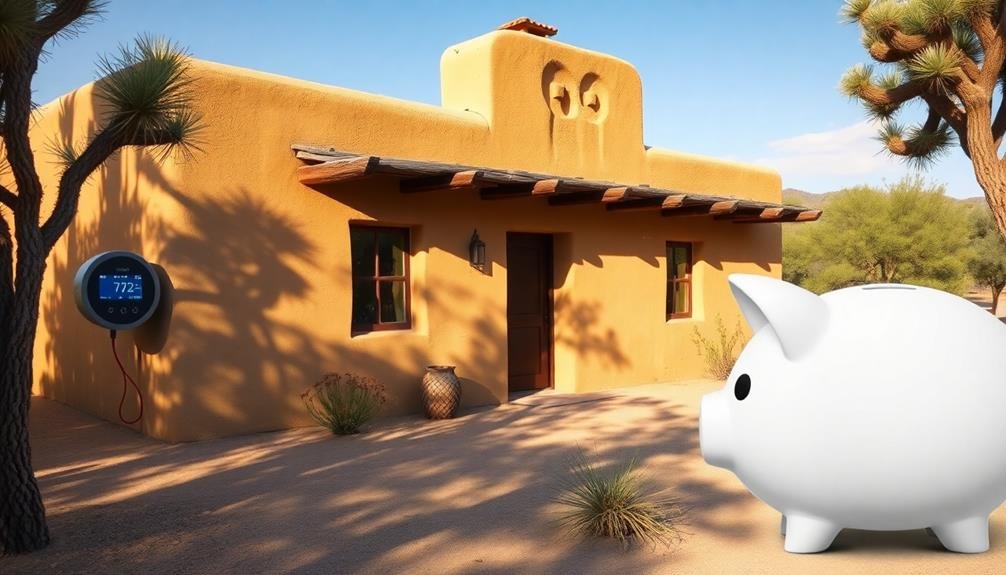
Numerous long-term cost savings are associated with adobe construction, extending well beyond reduced energy bills.
You'll find that the durability of adobe structures greatly reduces maintenance costs over time. These buildings can last for centuries with proper care, minimizing the need for frequent repairs or renovations.
Adobe's natural resistance to fire and pests means you'll spend less on insurance premiums and pest control. The thick walls also provide excellent sound insulation, potentially saving you money on additional soundproofing measures.
Furthermore, adobe's ability to regulate indoor humidity can prevent moisture-related issues, reducing the likelihood of costly mold remediation or structural damage.
You'll appreciate that adobe homes often appreciate in value due to their unique characteristics and energy efficiency. This can lead to higher resale values and potential tax benefits.
Additionally, the use of local materials in adobe construction can lower transportation costs and support the local economy.
Eco-Friendly Temperature Control
Adobe's cost-saving benefits extend beyond financial aspects to include environmentally friendly temperature regulation. You'll find that adobe structures naturally maintain a comfortable indoor temperature, reducing the need for energy-intensive heating and cooling systems.
This eco-friendly approach to climate control stems from adobe's high thermal mass, which absorbs heat during the day and releases it at night.
By utilizing adobe's natural temperature regulation properties, you're not only reducing your carbon footprint but also contributing to a more sustainable built environment. The thick walls of adobe buildings act as a buffer against extreme outdoor temperatures, creating a stable indoor climate that requires minimal artificial intervention.
Here are some key eco-friendly benefits of adobe's temperature control:
- Reduced reliance on HVAC systems
- Lower energy consumption for heating and cooling
- Decreased greenhouse gas emissions
- Improved indoor air quality due to natural ventilation
You'll appreciate how adobe's passive temperature regulation aligns with green building practices. By harnessing the earth's natural materials and properties, you're embracing a time-tested method of sustainable living that doesn't compromise on comfort or modern functionality.
Comfort and Well-Being Impact

Many residents of adobe homes report an enhanced sense of comfort and well-being. You'll experience a more stable indoor environment, with fewer temperature fluctuations throughout the day. This consistency can reduce stress on your body and improve your overall health.
Adobe's natural temperature regulation also means you'll sleep better at night. The walls absorb heat during the day and release it slowly in the evening, maintaining a comfortable sleeping temperature. You'll wake up feeling more refreshed and energized.
The thick adobe walls also provide excellent sound insulation, creating a quiet, peaceful atmosphere that can lower your stress levels and improve concentration. This tranquil environment is especially beneficial if you work from home or need a calm space to unwind after a busy day.
| Comfort Aspect | Adobe Home | Conventional Home |
|---|---|---|
| Temperature | Stable | Fluctuating |
| Sleep Quality | Improved | Variable |
| Noise Level | Low | Higher |
| Air Quality | Better | Standard |
| Stress Level | Reduced | Normal |
Frequently Asked Questions
How Does Adobe Compare to Other Natural Building Materials for Temperature Regulation?
You'll find adobe excels at temperature regulation compared to other natural materials. It absorbs heat during the day and releases it at night, keeping interiors cool in summer and warm in winter. It's more effective than wood or stone.
Can Adobe Be Effectively Used in All Climate Zones?
You can use adobe effectively in many climate zones, but it's best suited for hot, dry areas. It's less ideal in very humid or extremely cold regions where moisture management becomes challenging. Consider local climate carefully before choosing adobe.
What Are the Maintenance Requirements for Adobe Structures to Maintain Thermal Properties?
You'll need to regularly inspect and repair cracks, apply protective coatings, and guarantee proper drainage to maintain adobe's thermal properties. Don't forget to reapply exterior sealants every few years and keep the structure dry.
How Does Adobe's Temperature Regulation Affect Indoor Air Quality?
You'll enjoy improved indoor air quality with adobe's temperature regulation. It maintains stable humidity levels, reducing mold growth and dust mites. The natural materials also absorb pollutants, creating a healthier living environment for you and your family.
Are There Any Drawbacks to Using Adobe for Temperature Regulation?
You'll find some drawbacks to adobe's temperature regulation. It can create high humidity indoors, leading to mold growth. Adobe's thermal mass also means it's slow to adjust to sudden temperature changes, potentially causing discomfort.
In Summary
You've discovered the remarkable temperature regulation benefits of adobe. Its high thermal mass keeps your home naturally cool in summer and warm in winter. You'll enjoy reduced energy bills and a smaller carbon footprint. Adobe's ability to delay temperature fluctuations creates a more comfortable living environment. By harnessing these natural properties, you're not just building a house; you're creating a sustainable, energy-efficient home that'll keep you comfortable year-round while benefiting the planet.
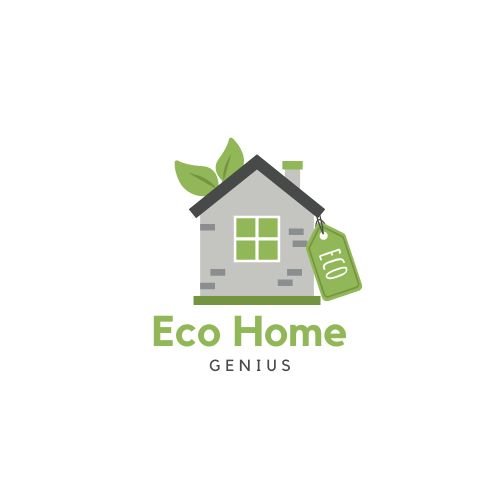




Leave a Reply